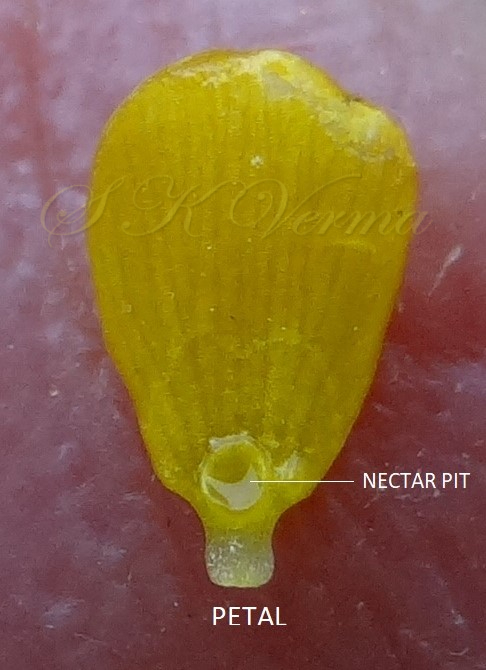RANUNCULUS
Ranunculus L., Sp. Pl. 1: 548. 1753; Gen. Pl. 5: 619. 1754; Boiss., Fl. Or. 1: 20. 1867; Hook. f. & Thoms. in Hook. f., Fl. Brit. India 1: 16. 1875; Qureshi & Chaudhari, Pak. Syst. 4(1-2): 140. 1988; Wencai & Gilbert, Fl. China @ eFloras.org 6: 391; Whitemore, Fl. North Amer. @ eFloras.org vol. 3; Riedl & Nasir, Fl. Pak. @ eFloras.org p. 125.
Annual or perennial herbs, terrestrial, rarely aquatic with fibrous, partly fibrous, partly fleshy or more or less tuberiform roots; stems usually leafy. Leaves basal, cauline or both, entire in some species, more often palmatifid or palmatipartite, lobate or rarely pinnate; all petiolate or distal leaves sessile, petiole expanded into sheath at base; cauline leaves mostly alternate; leaf blade reniform to linear, margin entire, crenate or toothed. Inflorescence terminal or axillary, 2-50-flowered, simple or paniculate cyme or flowers solitary, terminal or leaf-opposed; bracts foliose, not forming involucre or absent. Flowers actinomorphic, bisexual, hypogynous. Sepals (3-) 5 (-7), deciduous after anthesis, usually greenish. Petals 5, shortly clawed, yellow, rarely white, rarely more or less with a subbasal nectar pit often protected by a scale. Stamens usually numerous (rarely 5 or 10), spirally arranged, staminodes absent between stamens and pistils. Carpels usually numerous, up to 250, arranged in globose to oblong heads, free, usually sessile, ovaries unilocular with one basal ovule; style usually present; distinct stigma usually absent. Fruit aggregate, globose, ovoid or cylindric, with numerous achenes; achenes nut-like, inflated or +/- bilaterally compressed, usually with a distinct, straight or curved style (beak).
1691 species
Ranunculus scleratus
Ranunculus scleratusL., Sp. Pl. 1: 551. 1753; Boiss,, Fl. Or. 1: 52. 1867; Hook. f. & Thoms. in Hook. f., Fl. Brit. India 1: 19. 1875; Blatter, Beaut. Fl. Kashm. 1: 15. 1928; Collett, Fl. Siml. ed. 2: 10. 1921 (Reprint 1983); Maheshwari, IIIust. Fl. Delhi f. 41. 1966; Kaul, Weed Fl. Kashm. Valley 15. f. 4. 1986; Dhaliwal & Sharma, Fl. Kullu Dist. 110. 1999; Kaur & Sharma, Fl. Sirmaur 123. 2004; Singh & Sharma, Fl. Chamba Dist. 144. 2006; Tutin in Tutin et al., Fl. Eur. 1: 233. 1964; Fl. China @ eFloras.org 6: 421; Fl. North Amer. @ eFloras.org vol. 3; Riedl & Nasir, Fl. Pak. @ eFloras.org p. 132.
Annual herb; roots fibrous. Stem erect, somewhat fistular, 10-75 cm, leafy, glabrous or sparsely puberulent, branched above. Leaves basal and cauline. Basal leaves 5-13; petiole up to 21 cm long, sparsely pubescent. Leaf blades of basal and proximal cauline leaves reniform to semicircular or broadly ovate in outline, 1-5 cm x 1.5-6.8 cm, 3-lobed or 3-parted, base cordate or broadly cuneate, segments usually again lobed or parted: central lobe cuneate or rhombic, 3-lobed, lobules 1 or 2, denticulate or entire; lateral lobes obliquely broadly obovate or obliquely cuneate, unequally 2-lobed or 2-cleft to middle, apex rounded or occasionally obtuse; leaf lobes glabrous or abaxially puberulent. Upper cauline leaves alternate, shortly petiolate or sessile, cuneate at base, 3-sect, segments 0.5-3.5 cm x 0.5-2.5 cm, oblanceolate to linear. Inflorescence compound monochasia, terminal, corymbose; bracts leaf-like. Flowers actinomorphic, bisexual, hypogynous, 0.4-1.4 cm across, yellow; pedicels 0.5-1.5 cm, elongating in fruit, sparsely puberulent, receptacle puberulent or pubescent. Sepals 5, ovate-elliptic, obtuse, 2-5 mm x ca. 1.3 mm, deflexed from or near base, abaxially appressed puberulent. Petals 5, valvate, spreading obovate, shorter than sepals, 2.2-4.5 mm x 1.4-2.5 mm, yellow, adaxially with a subbasal nectar pit, scale absent or poorly developed as crescent-shaped or circular ridge around pit but not covering it. Stamens many, up to 19, spirally arranged around receptacle; filaments ca. 2 mm long; anthers ca. 0.5 mm long, ellipsoid. Pistils numerous, arranged on globose to oblong receptacles, heads sessile; ovaries unilocular with a basal ovule; style minute, asymmetrically inserted. Aggregate fruit oblong to shortly cylindric, 3-11 mm x 1.5-6 mm; achenes numerous, slightly bilaterally compressed, obliquely obovoid, inflated, 1-1.1 mm x 0.8-1 mm, faintly rugose; beak deltate, usually straight, 0.1 mm.
Flowering and Fruiting: January to April
Common Names: Cursed Crowfoot, Celery-leaved Buttercup, Cursed Buttercup, Ditch Crowfoot
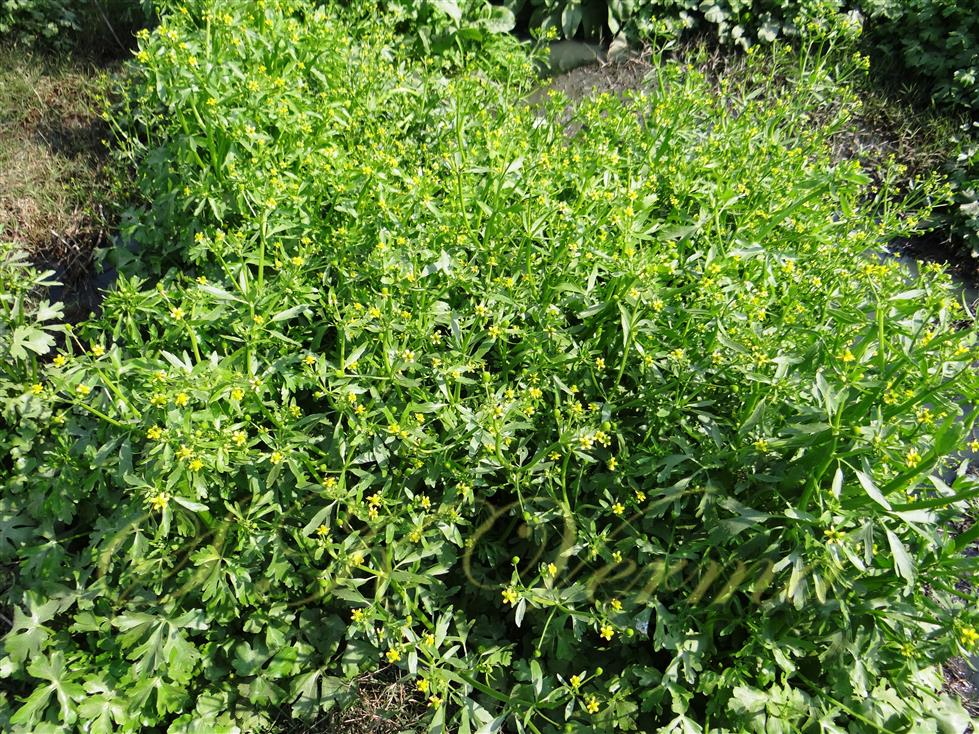
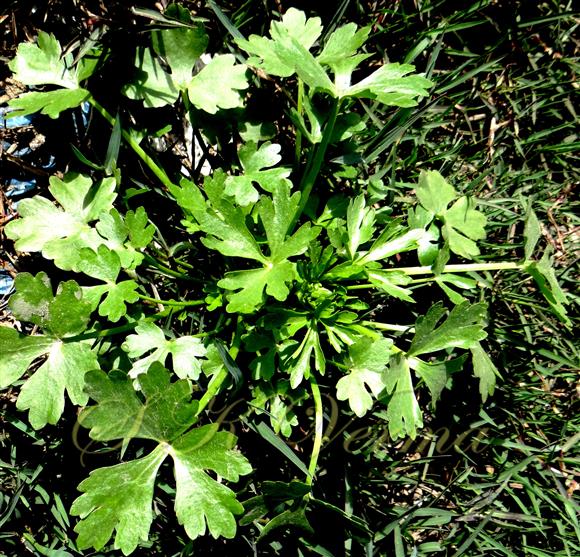
.jpg)
.jpg)
.jpg)
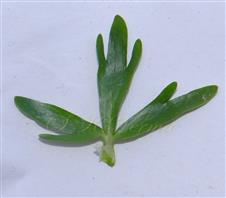
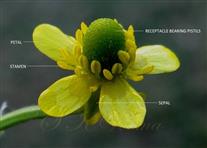
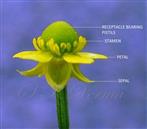

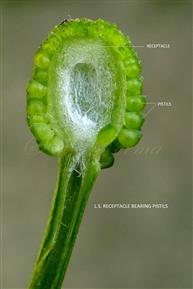



.jpg)
.jpg)
.jpg)



